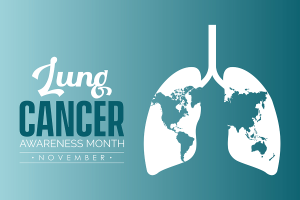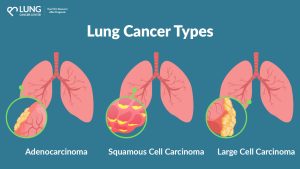
Health & Wellness 2024

Lung cancer is cancer that forms in tissues of the lung, usually in the cells that line the air passages. It is the leading cause of cancer death in both men and women. There are two main types: small cell lung cancer and non-small cell lung cancer. These two types grow differently and are treated differently.
Non-Small Cell Lung Cancer 
Non-small cell lung cancer is the most common type of lung cancer. More than 8 out of every 10 lung cancer cases are NSCLC. Within the non-small cell lung cancer category, there are 3 subtypes:
Adenocarcinoma is the most common form of lung cancer and begins in the cells in the glands located on the outer part of the lungs. It is most frequently found in women, non-smokers, and people under the age of 45.
Squamous cell carcinomas make up 25 – 30% of all lung cancers and are linked to a history of smoking. Squamous cell carcinomas are more common in men than in women. The majority of cases of squamous cell carcinoma start in the center of the lung. Often, and at an earlier stage than other tumors, squamous cell carcinomas cause symptoms such as coughing up blood.
Large cell carcinomas tend to grow quickly and are usually undetected until they have metastasized. The rarest of the lung cancers, large cell carcinomas only appear in roughly 1 in every 10 cases. As more precise diagnostics have become available, many lung cancers previously diagnosed as large cell carcinomas are being re-classified as adenocarcinoma or squamous cell lung cancer.
A lot of research is being done surrounding treatments for all forms of NSCLC and there are many clinical trials in the pipeline for patients navigating a NSCLC diagnosis.
Small cell lung cancer (SCLC)
Small cell lung cancer is a much less common form of lung cancer, affecting roughly 1 in every 10 people diagnosed with lung cancer. Small cell lung cancer is particularly aggressive. It often returns after initial rounds of chemotherapy.
Because of the Recalcitrant Cancer Research Act, the National Cancer Institute (NCI), in partnership with the lung cancer research community, is making SCLC a major focus of research, resulting in a greater number of clinical trials in the pipeline.
 Symptoms:
Symptoms:
Lung cancer typically doesn’t cause symptoms early on. Symptoms of lung cancer usually happen when the disease is advanced.
Signs and symptoms of lung cancer that happen in and around the lungs may include:
- A new cough that doesn’t go away.
- Chest pain.
- Coughing up blood, even a small amount.
- Hoarseness.
- Shortness of breath.
- Wheezing.
Signs and symptoms that happen when lung cancer spreads to other parts of the body may include:
- Bone pain
- Headache
- Losing weight without trying
- Loss of appetite
- Swelling in the face or neck
When to see a doctor:
Make an appointment with your doctor or other healthcare professional if you have any symptoms that worry you. If you smoke and haven’t been able to quit, make an appointment. Your healthcare professional can recommend strategies for quitting smoking. These may include counseling, medicines and nicotine replacement products.
 Thanksgiving, a time-honored holiday in the United States, is a time for gratitude, togetherness, and tradition. Families and friends across the nation gather to celebrate this holiday, and over the years, certain traditions have become deeply established. Here are the top five Thanksgiving traditions and the stories of how they came to be.
Thanksgiving, a time-honored holiday in the United States, is a time for gratitude, togetherness, and tradition. Families and friends across the nation gather to celebrate this holiday, and over the years, certain traditions have become deeply established. Here are the top five Thanksgiving traditions and the stories of how they came to be.
1. The Thanksgiving Feast
 The Thanksgiving feast is the centerpiece of the holiday, traditionally featuring a grand spread of turkey alongside plates full of side dishes including stuffing, cranberry sauce, mashed potatoes, and pumpkin pie. The tradition of a bountiful, shared meal of thanksgiving dates back to the early 17th century when the Pilgrims, newly arrived in Plymouth, Massachusetts, celebrated their successful harvest with a three-day feast. It was a way to give thanks for their survival and the help of the Wampanoag Native Americans. While the exact menu may have evolved over the centuries, the spirit of communal gratitude and sharing persists.
The Thanksgiving feast is the centerpiece of the holiday, traditionally featuring a grand spread of turkey alongside plates full of side dishes including stuffing, cranberry sauce, mashed potatoes, and pumpkin pie. The tradition of a bountiful, shared meal of thanksgiving dates back to the early 17th century when the Pilgrims, newly arrived in Plymouth, Massachusetts, celebrated their successful harvest with a three-day feast. It was a way to give thanks for their survival and the help of the Wampanoag Native Americans. While the exact menu may have evolved over the centuries, the spirit of communal gratitude and sharing persists.
2. Parades
 The Macy’s Thanksgiving Day Parade in New York City is perhaps the most famous of all Thanksgiving parades. First held in 1924, the parade features colossal balloons of beloved characters, marching bands, and celebrity performances. The idea for a parade started when employees of Macy’s wanted to celebrate the holiday in a unique way. Their vision was to bring people together, lift their spirits, and generate excitement for the upcoming holiday shopping season. Today, this tradition continues to captivate millions, both in person and through televised broadcasts, as they usher in the holiday season with a sense of wonder and awe.
The Macy’s Thanksgiving Day Parade in New York City is perhaps the most famous of all Thanksgiving parades. First held in 1924, the parade features colossal balloons of beloved characters, marching bands, and celebrity performances. The idea for a parade started when employees of Macy’s wanted to celebrate the holiday in a unique way. Their vision was to bring people together, lift their spirits, and generate excitement for the upcoming holiday shopping season. Today, this tradition continues to captivate millions, both in person and through televised broadcasts, as they usher in the holiday season with a sense of wonder and awe.
3. Football
 For many Americans, Thanksgiving Day means football. The tradition of football on Thanksgiving dates back to the late 19th century. The holiday quickly became associated with college football, with Yale and Princeton playing Thanksgiving games as early as 1876. By the early 20th century, the day also became the traditional time for rival high schools to play. Finally, professional football was added to the menu after the National Football League (NFL) was founded in 1920. The Detroit Lions began a tradition of playing a home game each Thanksgiving Day in 1934, which continues today. The Dallas Cowboys are also famous for their Thanksgiving games, which they have played each year since 1966.
For many Americans, Thanksgiving Day means football. The tradition of football on Thanksgiving dates back to the late 19th century. The holiday quickly became associated with college football, with Yale and Princeton playing Thanksgiving games as early as 1876. By the early 20th century, the day also became the traditional time for rival high schools to play. Finally, professional football was added to the menu after the National Football League (NFL) was founded in 1920. The Detroit Lions began a tradition of playing a home game each Thanksgiving Day in 1934, which continues today. The Dallas Cowboys are also famous for their Thanksgiving games, which they have played each year since 1966.
4. Turkey Pardoning
 The presidential turkey pardon is a more recent tradition that has gained significant attention. Every year, the President of the United States “pardons” a turkey, sparing it from becoming Thanksgiving dinner. The origins of this tradition are somewhat debated; legend has it that Abraham Lincoln supposedly pardoned a turkey in 1863. But it wasn’t until 1989, under President George H. W. Bush that the first formal pardon was granted. The lighthearted ceremony, often accompanied by jokes and puns, highlights the presidential sense of humor while symbolizing the holiday’s message of mercy and thankfulness.
The presidential turkey pardon is a more recent tradition that has gained significant attention. Every year, the President of the United States “pardons” a turkey, sparing it from becoming Thanksgiving dinner. The origins of this tradition are somewhat debated; legend has it that Abraham Lincoln supposedly pardoned a turkey in 1863. But it wasn’t until 1989, under President George H. W. Bush that the first formal pardon was granted. The lighthearted ceremony, often accompanied by jokes and puns, highlights the presidential sense of humor while symbolizing the holiday’s message of mercy and thankfulness.
5. Volunteering and Giving Back
 Thanksgiving is not only a time for personal reflection but also a time to give back to those in need. Community service, volunteering, and charitable giving have become deeply ingrained in the holiday spirit. Thanksgiving is a time for sharing food with those less fortunate, which can be achieved by volunteering at local food banks or giving to charities who provide food to vulnerable people around the world. This tradition of kindness and compassion serves as a reminder of the true meaning of Thanksgiving – to share blessings and support the community.These traditions, deeply rooted in American culture, remind us of the significance of Thanksgiving as a time for family, gratitude, and unity. While the specifics of the celebrations may evolve over time, the core values of thankfulness and togetherness remain constant. From the historical roots of the Pilgrims’ feast to the modern-day celebrations, Thanksgiving traditions in the United States continue to be cherished and passed down from one generation to the next, keeping the spirit of the holiday alive.
Thanksgiving is not only a time for personal reflection but also a time to give back to those in need. Community service, volunteering, and charitable giving have become deeply ingrained in the holiday spirit. Thanksgiving is a time for sharing food with those less fortunate, which can be achieved by volunteering at local food banks or giving to charities who provide food to vulnerable people around the world. This tradition of kindness and compassion serves as a reminder of the true meaning of Thanksgiving – to share blessings and support the community.These traditions, deeply rooted in American culture, remind us of the significance of Thanksgiving as a time for family, gratitude, and unity. While the specifics of the celebrations may evolve over time, the core values of thankfulness and togetherness remain constant. From the historical roots of the Pilgrims’ feast to the modern-day celebrations, Thanksgiving traditions in the United States continue to be cherished and passed down from one generation to the next, keeping the spirit of the holiday alive.
THE PERFECT THANKSGIVING FEAST GRAVY

| Yields: | Prep Time: | Total Time: | Calories: |
| 8 |
10 minutes |
30 minutes |
80 |
- Butter: Butter is a wonderful fat for roux. As the roux cooks, the milk solids in the butter begin to brown, infusing the roux with all sorts of nutty brown-butter flavors.
- Flour: Flour provides the starch for our roux. When this starch binds with butter fat during cooking, we get a thickener that’s ideally suited to giving our gravy the creamy-velvety texture we want.
- Drippings: As your turkey roasts, it will render a ton of fat. Don’t—I repeat, don’t—pour that fat into the garbage. That fat = drippings! And those drippings are packed with flavor that you need for a perfect Thanksgiving gravy.
- Chicken Broth or Stock: If you have homemade stock socked away in the back of your freezer, now’s the time to use it; otherwise, low-sodium chicken broth will more than do the trick.
- Herbs: Something about the combination of woodsy sage and citrusy-minty thyme always evokes the holidays for me. I prefer the bright flavors of fresh herbs in my gravy, but feel free to substitute dried herbs if you like.
Directions
Recipe Tips
-
How to collect pan drippings: After you take the turkey out of the roasting pan, set a colander or fine-mesh sieve over a large bowl or another pan. Pour the contents of the roasting pan through the colander—the drippings you want to keep will end up in the large bowl. You can discard the bits left in the colander. If you’d prefer to not deal with the drippings (or want to make gravy without having to cook a turkey), check out our gravy without drippings recipe.
-
What if I don’t have a full cup of drippings? If you’re short on drippings, just add more stock. The reverse is also true: If you have more than a cup of drippings, use that and reduce the amount of stock in equal proportion.
